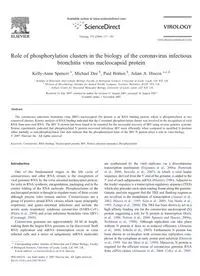
2008 Role of phosphorylation clusters in the biology of the coronavirus infectious bronchitis virus nucleocapsid protein PDF
Preview 2008 Role of phosphorylation clusters in the biology of the coronavirus infectious bronchitis virus nucleocapsid protein
Role of phosphorylation clusters in the biology of the coronavirus infectious bronchitis virus nucleocapsid protein Kelly-Anne Spencer a, Michael Dee b, Paul Britton b, Julian A. Hiscox a,c,⁎ a Institute of Molecular and Cellular Biology, Faculty of Biological Sciences, University of Leeds, Leeds, LS2 9JT, UK b Division of Microbiology, Institute for Animal Health, Compton, Newbury, Berkshire, RG20 7NN, UK c Astbury Centre for Structural Molecular Biology, University of Leeds, Leeds, LS2 9JT, UK Received 16 July 2007; returned to author for revision 11 August 2007; accepted 16 August 2007 Available online 1 November 2007 Abstract The coronavirus infectious bronchitis virus (IBV) nucleocapsid (N) protein is an RNA binding protein which is phosphorylated at two conserved clusters. Kinetic analysis of RNA binding indicated that the C-terminal phosphorylation cluster was involved in the recognition of viral RNA from non-viral RNA. The IBV N protein has been found to be essential for the successful recovery of IBV using reverse genetics systems. Rescue experiments indicated that phosphorylated N protein recovered infectious IBV more efficiently when compared to modified N proteins either partially or non-phosphorylated. Our data indicate that the phosphorylated form of the IBV N protein plays a role in virus biology. © 2007 Elsevier Inc. All rights reserved. Keywords: Coronavirus; RNA binding; Nucleocapsid protein; IBV; Surface plasmon resonance; Phosphorylation Introduction One of the fundamental stages in the life cycle of coronaviruses and other RNA viruses is the recognition of viral genomic RNA by the virus encoded nucleocapsid protein, for roles in RNA synthesis, encapsidation, packaging and in the correct folding of the RNA molecule. Phosphorylation of the nucleocapsid protein is thought to regulate many of these events although precise roles remain unclear. Coronaviruses are a group of positive strand RNA viruses which cause principally respiratory and gastro-intestinal infections and include the severe acute respiratory syndrome coronavirus (SARS-CoV) (Peiris et al., 2004) and avian infectious bronchitis virus (IBV) (Cavanagh, 2005). Coronavirus genomes are approximately 30 kb in length, making them the largest RNA genomes so far discovered. Both RNA replication and mRNA transcription occur in virus infected cells and a series of subgenomic mRNA molecules are synthesized by the viral replicase via a discontinuous transcription mechanism (Enjuanes et al., 2006a; Pasternak et al., 2006; Sawicki et al., 2007), in which a viral leader sequence, derived from the 5′ end of the genome, is added to the 5′ end of each subgenomic mRNA (Masters, 2006). Adjacent to the leader sequence is a transcription regulatory sequence (TRS) which also precedes each open reading frame along the genome. Genetic analysis suggests that the TRS and flanking sequences are involved in the modulation of transcription (Alonso et al., 2002; Hiscox et al., 1995; Sola et al., 2005; Van Marle et al., 1995; Zuniga et al., 2004). The TRS has been shown to act as a high affinity binding site for the coronavirus nucleocapsid (N) protein suggesting a role for N protein in transcription (Baric et al., 1988; Nelson et al., 2000; Spencer and Hiscox, 2006a; Stohlman et al., 1988). Although replication can take place without N protein it does so at reduced efficiency (Almazan et al., 2004; Schelle et al., 2005). Furthermore N protein has been shown to co-localize with coronavirus replication com- plexes in the cytoplasm at early points post-infection (Denison et al., 1999; Van der Meer et al., 1999). Moreover, N protein is required for the efficient rescue of coronavirus genomic RNA from cDNA clones (Almazan et al., 2004; Coley et al., 2005; Available online at www.sciencedirect.com Virology 370 (2008) 373–381 www.elsevier.com/locate/yviro ⁎ Corresponding author. Institute of Molecular and Cellular Biology, Faculty of Biological Sciences, University of Leeds, Leeds, LS2 9JT, UK. E-mail address:
